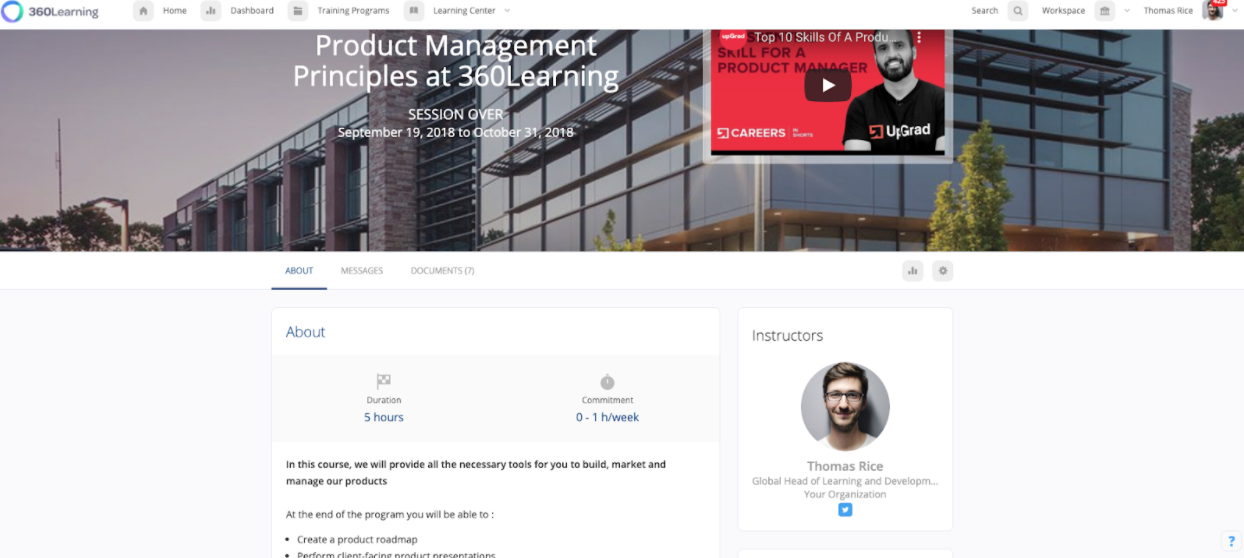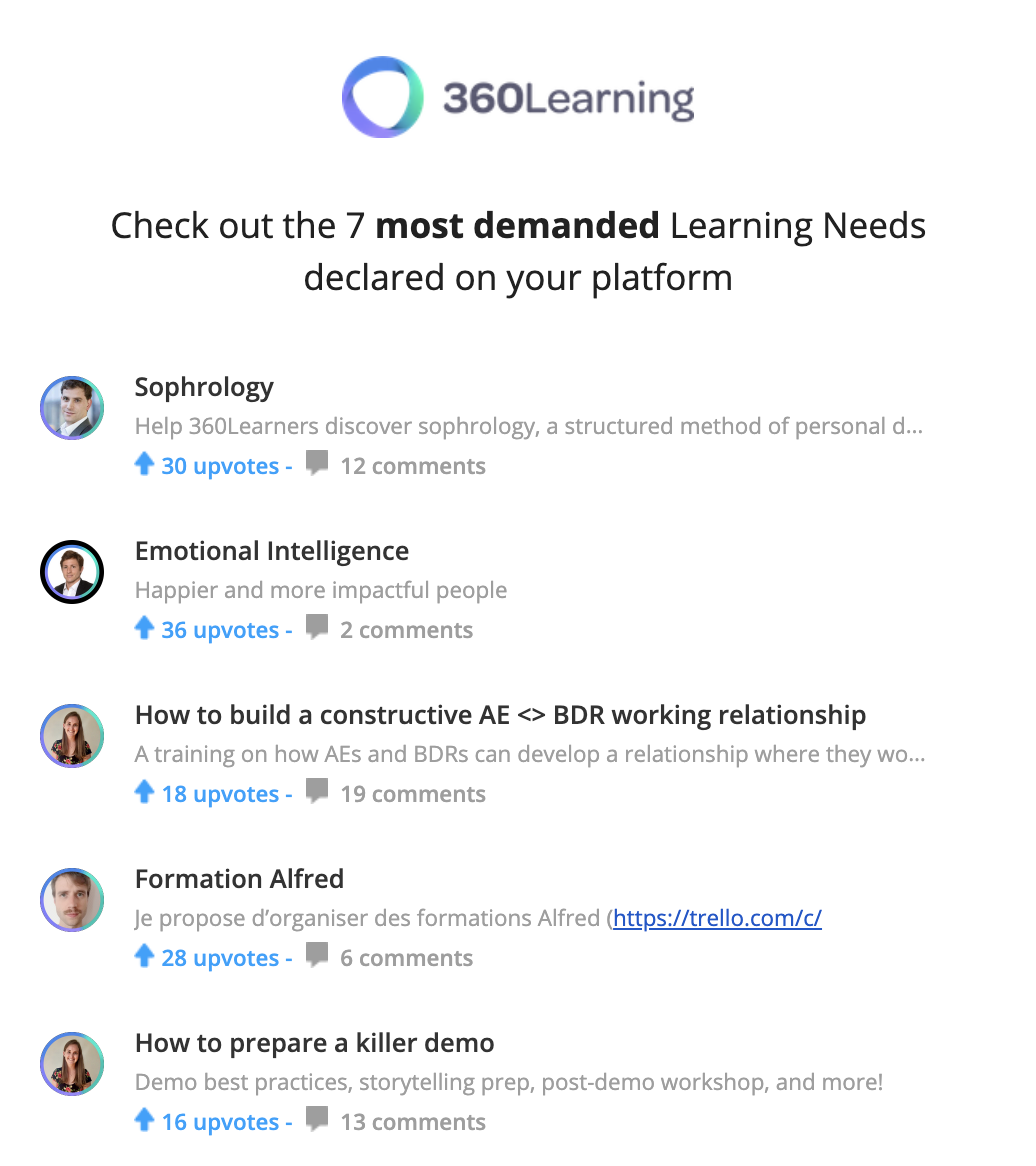At 360Learning, we don’t just preach the benefits of collaborative learning—we live them. Learning from one another daily is deeply embedded in our team culture and values.
This emphasis on peer learning doesn’t just make our team smarter; it makes us better at our jobs and directly contributes to our company’s growth. 360Learning currently powers the future of work at 2,300 organizations. We were founded in 2013, and have raised $240 million with 300+ team members across New York, Paris, and London.
Building a collaborative learning culture doesn’t happen overnight. Over the past few years, we’ve designed an organizational model of intertwined work and growth called Convexity, with the goal of helping each team member have an exponential impact on the company.
We’ve mentioned our unique company culture a lot in our Onboarding Joei docu-series, and a lot of people were very curious to know more. So here’s how we incorporate peer-to-peer learning into the very fiber of our company, and how it helps us cultivate sharp employees so we stay ahead of the curve in a crowded industry.
We guide employees through a collaborative onboarding process
New employees start their peer learning journey from their first day on the job. We’ve created an extensive onboarding process that combines both our own collaborative learning platform and in-person training to quickly help new hires get settled into the company’s workflows and culture.
Onboarding new hires can be time-consuming for coaches, especially in a company that’s growing as quickly as we are. Plus, a poor onboarding experience can negatively impact employee retention. Instead of forcing coaches to go over the same materials with each new employee, we’ve set up a program of asynchronous courses that employees can do at their own pace.
This learning strategy includes creating company-wide courses about our culture, processes, and tools, as well as department-specific content. Coaches create bespoke content for specific roles to make sure that each employee has the technical knowledge and training they need.
These online courses are coupled with in-person learning opportunities with the new hire’s coach who answers questions, helps them set OKRs, and oversees their 90-day probationary period. The coach monitors the new hire’s progress with various onboarding activities and can help them prioritize which courses to pursue. Through this combination of standardized and customized courses as well as individual coaching, each new hire gets their own tailored learning experience.
Maria Van Thienen, our sales enablement manager, says that by using asynchronous course modules, she can “onboard multiple people at the same time, and only spend [her] time and [her] sales coach’s time on refining and perfecting [their] new team members’ skills.”

This system also lets coaches save time by creating training once, and then calibrating them based on constructive feedback from learners. “I can see the impact of the training that I’m creating,” says Maria. “I can see how many people actually follow the training, and then I can see if it was helpful for them. ”
The result isn’t just more efficient onboarding; active learning opportunities leads to more capable employees. Coaching and 360 degree reviews ensure nobody slips between the cracks. Jonah Goldstein, our head of learning, says, “For new hire onboarding, we have defined specific milestones new hires need to hit in order to be considered ramped up for their job. Through peer-to-peer assessments, we can make sure our new hires are ready to have the most impact—we set them up for success.”
Want to see what that looks like in reality? Check out episodes 1-3 of our docu-series, Onboarding Joei.
We decentralize the learning process
While many companies might rely solely on a Learning and Development department to define their learning needs and create courses, we’re able to use our collaborative learning platform to create a more democratic and distributed learning process.

Using our learning tool, team members declare their needs, which can then be upvoted by others, with the most in-demand courses taking priority. Other people across the company can then volunteer to create a course to meet that particular need. This becomes a continuous process, putting employees in charge of their own learning needs and creating learning partnerships.
Our company has offices in New York, London, and Paris, as well as some entirely remote employees. Our decentralized structure lets us capitalize on internal knowledge, even when we’re not in the same building. Being able to learn from each other, even across different time zones, is hugely important. This type of peer teaching made it easier for us to adapt to the COVID-19 lockdowns.
This decentralized setup is a faster and more agile learning system than a traditional L&D department can execute. Colleagues can share knowledge and expertise at a much quicker rate than through a centralized learning function.
It also lets coaches continually iterate on what content will have the most impact on their teams. “You’re collaborating with so many people to create content, which makes launching new courses so much easier,” says Maria. “They’re generating the content, you launch it, and you see what sticks with your team, and then you double down on creating more content like that.”
“You’re collaborating with so many people to create content, which makes launching new courses so much easier.”
We make everyone a subject matter expert
Along with getting to know and understand our product, one of the first things new employees must do at the company is to earn their right to become a course author. They go through a product discovery course, then become an author on the platform so they can start creating content.
Every person in our company has deep expertise in their own set of specific subjects. By letting anyone respond to requests and create courses, we’re able to unlock that wisdom and let the entire company benefit from peer feedback.
“When you have a big sales team spread over three different countries,” says Maria, “a lot of the reps know a lot of things that others might not know. The platform enables us to capitalize on that knowledge a lot more efficiently.”
Creating subject matter experts out of our employees isn’t just efficient, but it’s rewarding, too. Becoming a Learning Leader and contributing to a colleague’s personal growth and performance is immensely satisfying. It’s part of what Jonah calls “a virtuous circle” that drives problem-solving, recognition, engagement, teamwork, and growth.
We encourage peer learning outside the scope of work
We’re a learning organization, so we encourage our employees to continuously learn about any subject that might interest them. And we do mean any subject.
Team members can offer courses on anything they like, whether it’s directly related to the work we do or not. We want our team members to feel free to learn beyond their job description, while at the same time engaging with each other and the larger world.
These classes often have real-world applications. When coronavirus was first coming to the fore, we had a team member offer to create a course on the existing research about the disease, what the risks are, and how people can protect themselves. Another team member offers a Sophrology class that we did in person (you can see it in action at minute 4:38 in episode 3 of “Onboarding Joei”).
Because we’re a diverse and multicultural company spread across two continents, these courses also play a pivotal role in social learning and cross-cultural understanding. For example, our teammate Alex offered to create a course to help teach our European coworkers about gun rights and the second amendment in the US constitution.

His course proved to be highly engaging, and received a lot of positive feedback from our team (see forum):

With the benefits of peer learning, you create a more solid community and help individual workers become more invested in the company as a whole. Encouraging team members to share their skills and knowledge leads to deeper peer interactions and higher employee satisfaction.
In other words: Happy, involved employees stick around. “We had a bit of a turnover issue in 2018,” says Jonah. “In 2019, we saw a drop in that, which we attribute to people being more engaged and learning faster.”
Leverage peer learning for your company’s growth
There’s no one right way for a company to grow, no one-size-fits-all formula for incorporating peer learning into your company. We have Convexity and that works wonders for us. But each company needs to create its own culture and values and employ the right L&D tools to support a collaborative learning environment.
At the root of our success is a strong culture of learning that helps motivate people to grow and be productive. We make learning a part of our everyday lives, which leads to high-performing, impact-oriented team members, and a stronger team.
Want to learn about how to retain employees in this new world of work? Check out our on-demand webinar with Hibob.


